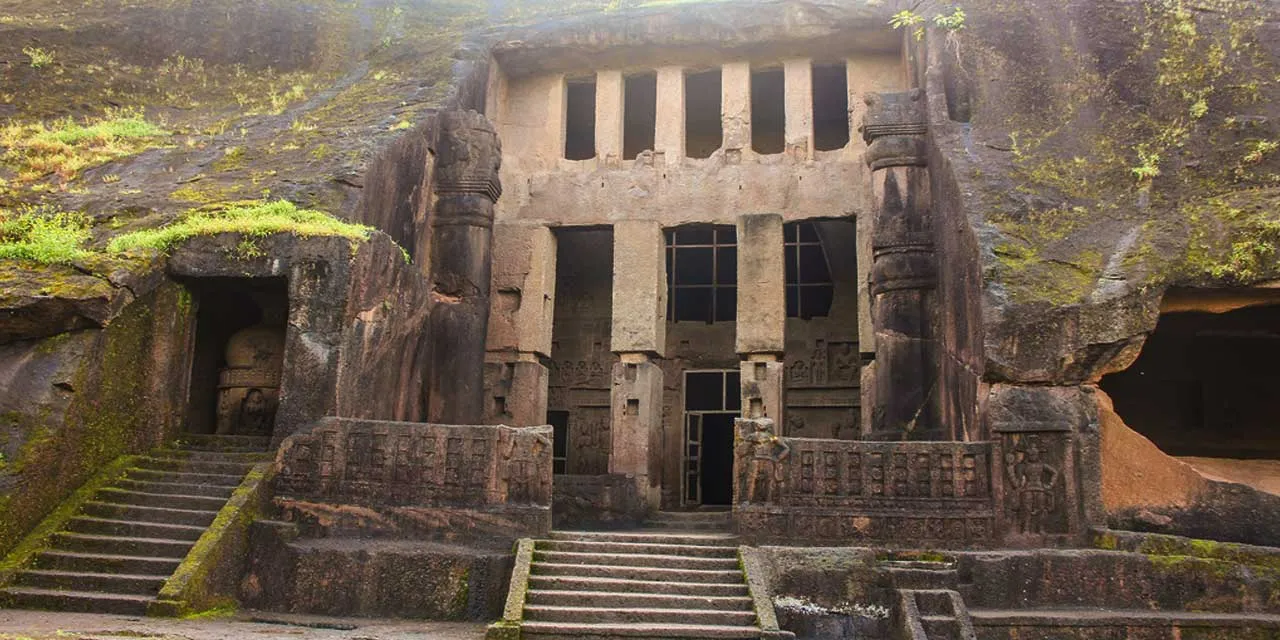The Kanheri Caves, situated within the picturesque Sanjay Gandhi National Park in Mumbai, hold a rich and enigmatic history within their rocky embrace that dates back centuries. These ancient caves have stood as witnesses to the rise and fall of empires, the evolution of religious practices, and the passage of time. Wondering about how to reach Kanheri Caves? We’ve got you covered.
To reach the Kanheri Caves Mumbai, you can either trek or take a bus. The park provides regular bus services that take visitors to the base of the caves. Alternatively, you can trek through the scenic forest trail, adding an adventurous touch to your journey. In this detailed blog, we will delve into the captivating history of the Kanheri Caves, exploring their origins, significance, and the stories they silently narrate.
Origins and Development of Kanheri Caves
The Kanheri Caves in Mumbai, a testament to the rock-cut architecture of ancient India, were carved into the basalt rock between the 1st century BCE and the 10th century CE.
Originally known as Krishnagiri, the Kanheri caves were an important Buddhist center for millennia. With a total of 109 caves, the site was a hub of monastic activity, housing Buddhist monks who sought seclusion, meditation, and knowledge.
The Mauryan Connection
The Influence of Emperor Ashoka:
The earliest records of the Kanheri Caves in Mumbai can be traced back to the reign of Emperor Ashoka, the Mauryan ruler who embraced Buddhism and propagated its teachings. It is believed that the caves were initially excavated during this period as a retreat for Buddhist monks.
Legacy of the Mauryan Empire:
The Mauryan influence on the Kanheri Caves in Maharashtra is evident in the architectural style, particularly in the early caves that showcase simple viharas or monastic dwellings. The caves also bear inscriptions and carvings associated with Ashoka’s patronage of Buddhism.
Flourishing during the Buddhist Era
A Center of Learning:
The Kanheri Caves in Mumbai became a major Buddhist university during Buddhist ascendancy in India. Monks from far and wide traveled to the caves to study Buddhist scriptures, philosophy, and meditation techniques. The caves served as a hub for intellectual and spiritual pursuits, attracting scholars, philosophers, and seekers of enlightenment.
Architectural Marvels:
The Kahneri caves evolved, with later additions showcasing more elaborate features. The chaityas (prayer halls) and viharas (monasteries) were adorned with intricate carvings, sculptures, and paintings that depicted Buddhist deities, stories, and symbols. The grandeur and artistry of these structures reflected the flourishing of Buddhist culture and artistic expressions during this era.
The Transition to Other Influences
Hindu and Jain Influence:
With the decline of Buddhism in India, the Kanheri Caves in Mumbai saw a transition in religious patronage. Some caves underwent modifications and additions by subsequent Hindu and Jain rulers, who incorporated their religious elements into the existing structures.
The Arrival of the Portuguese:
In the 16th century, the Portuguese arrived on the shores of Mumbai and used the Kanheri caves as a base for their troops. The remnants of their presence can still be seen as inscriptions and graffiti left behind on the cave walls.
Rediscovery and Preservation
Rediscovery in the Modern Era:
The Kanheri Caves in Mumbai lay forgotten for centuries until their rediscovery by the British in the 19th century. Since then, efforts have been made to study, preserve, and restore these architectural gems, ensuring their protection for future generations.
Recognition as a UNESCO World Heritage Site:
In 2019, the Kanheri Caves in Mumbai, Maharashtra, along with the surrounding Sanjay Gandhi National Park, received the prestigious designation of a UNESCO World Heritage Site. This recognition highlights the global significance of the caves and the need for their conservation.
Lesser-Known Facts about Kanheri Caves in Mumbai
While exploring the Kanheri Caves, several fascinating facts are often overlooked. These lesser-known details add another layer of intrigue to this remarkable site. Here are some intriguing facts about the Kanheri Caves:
Intricate Paintings of Lord Buddha:
Within the caves, you can find approximately 30 incomplete paintings of Lord Buddha. These artistic depictions, although unfinished, offer a glimpse into the rich tradition of cave art and the reverence for Lord Buddha.
A Breath of Fresh Air:
One of the lesser-known aspects of the Kanheri Caves is their location within the verdant surroundings of the Sanjay Gandhi National Park. This unique setting allows visitors to enjoy the fresh air and a peaceful environment away from the bustling city of Mumbai.
A Record-Breaking Site:
The Kanheri Caves have the highest number of excavations from a single hill. Over the centuries, the skilled artisans carefully carved out the black basaltic rock, creating a vast cave complex that is a testament to their craftsmanship and dedication.
Continued Significance for Buddhists:
Even today, the Kanheri Caves in Mumbai, Maharashtra maintain their importance as learning centers for Buddhists. The serene and spiritual ambiance of the caves continues to attract Buddhist practitioners who come to meditate, study, and find solace in this ancient site.
A Secluded Cemetery:
One intriguing feature of the Kanheri Caves in Mumbai is the presence of a cemetery on a secluded terrace. This unique addition highlights the various aspects of life once intertwined within the caves, including rituals associated with death and remembrance.
Planning Your Visit: A Practical Guide
Planning a trip to the caves becomes simpler when you know what to expect. This section brings together all essential details in one place so visitors can move confidently. It helps you understand routes, entry rules and other practical points before you begin.
How to Reach Kanheri Caves
Reaching the caves is simple when you know the route and essential details. This section gives clear information to help you plan your journey smoothly. The caves sit deep inside Sanjay Gandhi National Park, Borivali East, making them one of Maharashtra’s most accessible heritage sites near Mumbai.
You can either take the official SGNP bus service to the base or choose the forest trek. The bus offers convenience, while the trek gives you a scenic path filled with greenery and fresh air. Remember that you need two tickets: one for the park and another for the caves. Keep them ready to avoid delays at checkpoints. This practical information ensures a stress-free trip.
Enhancing Your Experience
Small choices make your visit more meaningful and enjoyable. A private guided tour adds depth, offering context about the carvings, architecture and the long history of kanheri caves. With expert explanations, the site feels richer and more immersive.
Wear comfortable walking shoes and carry enough water. An early start helps you avoid the heat and peak crowds. The forest around the caves feels peaceful and refreshing. You may notice wildlife, moving leaves, and clean air that makes the walk pleasant. SGNP shows the quiet beauty of Maharashtra that many visitors miss.
Lesser-Known Facts & Lasting Legacy
Kanheri Caves hold layers of history that most travellers overlook. These points reveal the quieter stories behind the complex, helping you understand its cultural and spiritual importance. Each detail adds depth to the long history of kanheri caves.
Hidden Stories of the Caves
Kanheri holds secrets that most tourists miss. These brief points help you explore deeper layers of the complex. Each fact reveals something unique about the history of kanheri caves and its lasting spiritual influence.
A Record of Craftsmanship: The complex has the highest number of excavations from a single hill.
Unfinished Art: Around 30 paintings of Buddha remain incomplete, giving clues to ancient art.
A Place for Rituals: The secluded terrace cemetery once hosted important ceremonies.
Living Heritage: Even today, monks use the caves for meditation and learning.
About Kanheri Caves: The site reflects centuries of monastic life and cultural evolution.
Conclusion
The history of the Kanheri Caves is a testament to the multi-faceted cultural tapestry of India. Include this in your itinerary for your next Mumbai Tours.
From their origins as a retreat for Buddhist monks to becoming a bustling center of learning and spirituality, these caves have witnessed the ebb and flow of civilizations.
Exploring the Kanheri Caves offers a glimpse into the past. It invites us to reflect on the shared heritage and the timeless wisdom they embody.
You can also opt for private Kanheri Caves tour for a detailed understanding of the significance of Kanheri Caves in Mumbai.
As we walk in the footsteps of those who sought enlightenment within these ancient walls, we are reminded of the enduring power of human creativity, faith, and the quest for knowledge.
FAQs
People often search who built kanheri caves. The caves were carved over centuries by Buddhist monks who used the hill as a centre of learning and meditation.
Visitors ask how old is kanheri caves are. The earliest excavations date back to the 1st century BCE, making Kanheri one of the oldest monastic sites near Mumbai.
Travellers often search where is kanheri caves located. It stands inside Sanjay Gandhi National Park, Borivali East.
Kanheri caves built by Buddhist monks who slowly expanded the network of cells, halls and stupas over hundreds of years.







